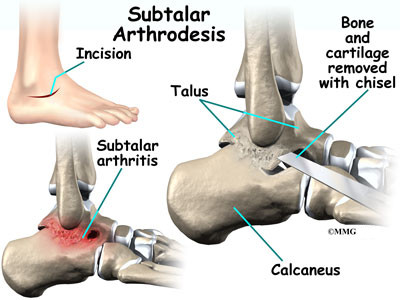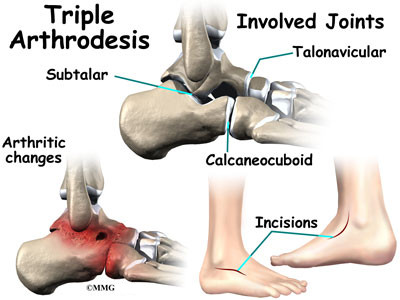Arthrodesis
Arthrodesis ( Greek: ἄρθρον Arthron, joint ' and δέσις desis, tying ') is an operational joint stiffness, the ability to move the joint is thereby suppressed completely. Here, either the joint opened ( intra-articular arthrodesis ) or not opened ( or extra-articular arthrodesis paraartikuläre ). Is temporary fixation transversely applied by a hinge, such as a K- wire, there is a temporary arthrodesis.
Arthrodesis of the spine is called spinal fusion. The natural ( disease-related ) joint stiffening is called ankylosis.
The operative joint stiffness is possible in principle at all joints. Hip and Kniearthrodesen have become rare since the introduction of endoprostheses. Quite often, the process is still carried out on the shoulder, hand, ankle and foot joints. Arthrodesis of the first tarsometatarsal joint ( Lapidus arthrodesis ) is a common method for the correction of severe hallux valgus unstable and the metatarsophalangeal joint arthrodesis is often carried out at a hallux rigidus.
Indications
An arthrodesis is performed, for example in severe osteoarthritis in chronic joint instability due to a paralysis, or to correct a severe deformity (such as hallux valgus ). Arthrodesis in the case of osteoarthritis an alternative to joint prosthesis and resection - interposition arthroplasty.
Furthermore, an arthrodesis in flaccid paralysis, be carried out by, for example, poliomyelitis, usually in the ankle region, thereby to achieve sufficient stability.
In patients with tetraplegia Arthodesen serve in the wrist area with tendon transfers to finger movements and va restore a gripping function using deflected not paralyzed muscles.
Arthrodesis come occasionally in joints in question, which were destroyed by a purulent arthritis or periarticular osteomyelitis.
Implementation
The method of the open arthrodesis provides a resection of the cartilaginous portions of the articulation, often with a distance of the underlying bone, whereby an axis correction can be achieved. Then usually takes place internal fixation with osteosynthesis. It can cannulated ( hollow ) screws are used (as in the picture of shoulder arthrodesis ), K - wires, intramedullary nails or plates. This depends on the location of the arthrodesis, the surgeon's preference and the particular indication. To improve bone healing have a private bone graft ( iliac crest cancellous bone ) or artificial bone replacement materials can be deposited. After the surgery is usually several weeks of immobilization in a cast or splint necessary so that a bony fusion of the former joint takes place.
Complications
The consequence of the stiffening is a partial or complete transfer of motion through adjacent joints, which can be medium to long term also damaged. The decision to arthrodesis should therefore take into account the state of the neighboring joints also always. However, this more true arthrodesis of large joints, which are now performed less frequently. The loss of function in arthrodesis in the foot and ankle area can be compensated very well and sometimes requires an adjustment sole ( sole role ), a insoles, shoe dressing or orthopedic custom made shoe. In instabilities arthrodesis can even restore previously lost functions especially in the hand area.
A lack of bony fusion of the arthrodesis (pseudarthrosis ) is frequently observed in arthrodesis of large joints, but rarely in the foot and ankle area.










